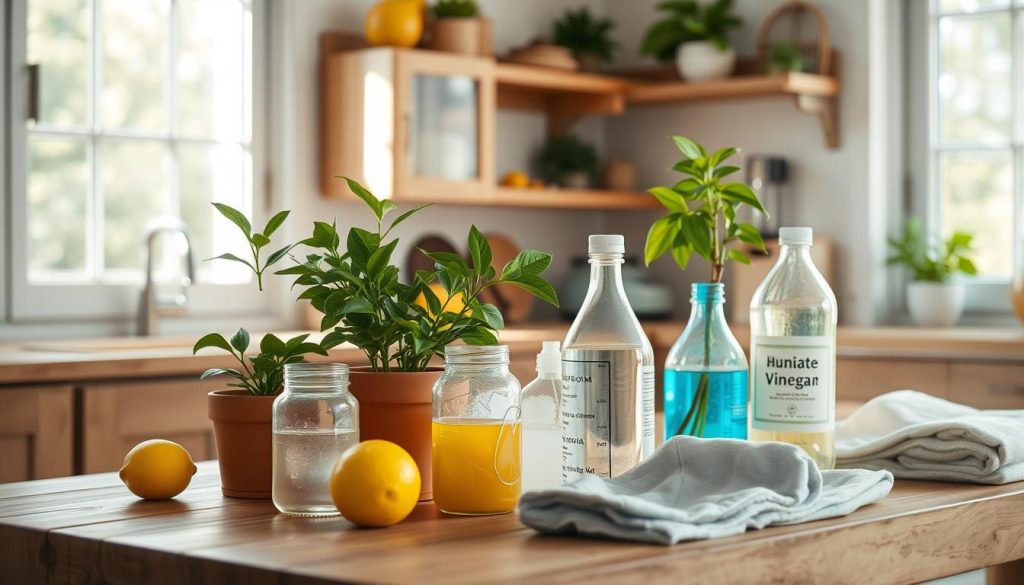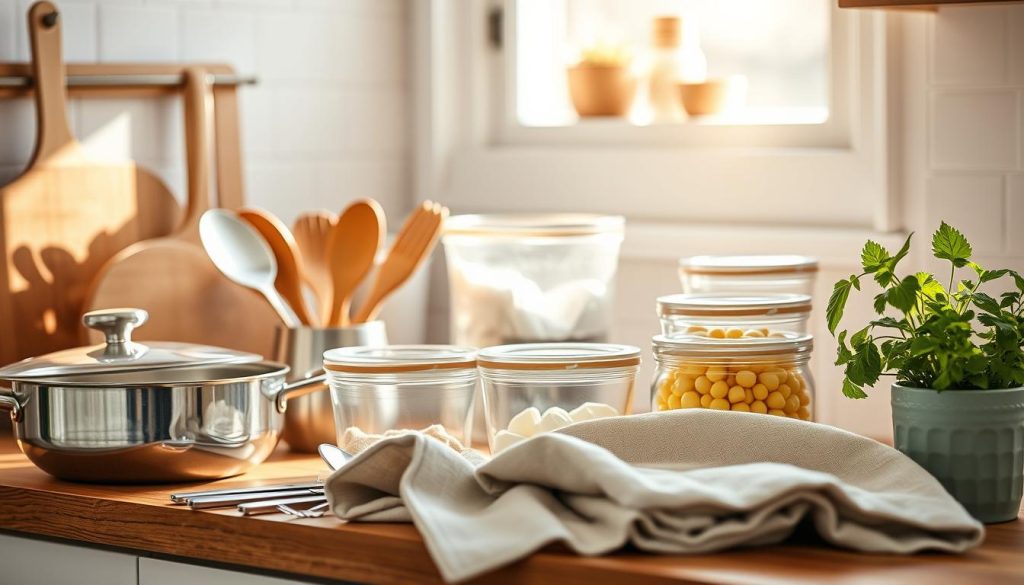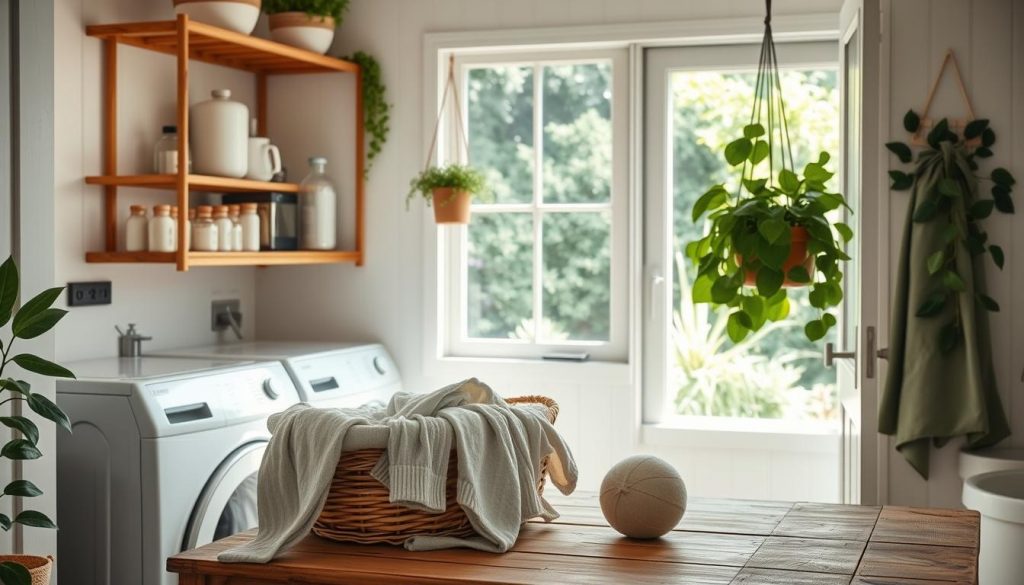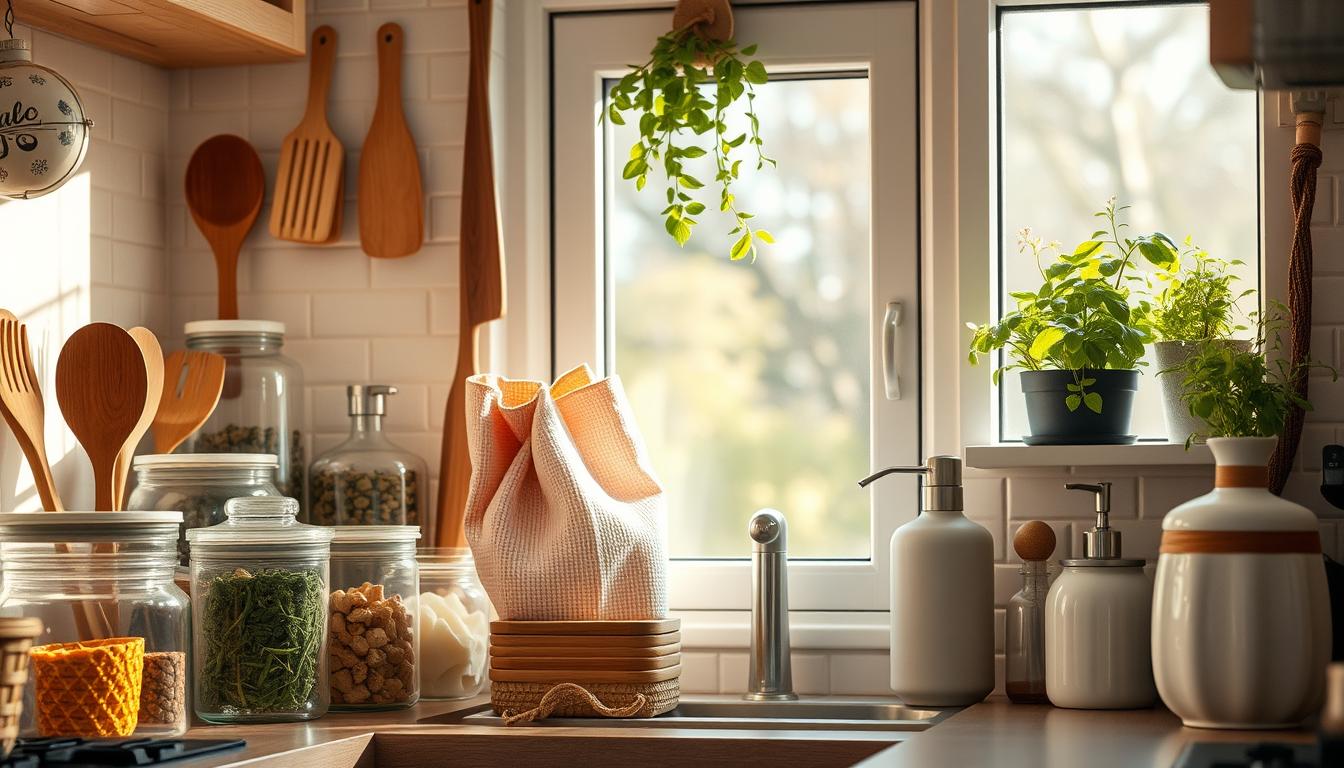I’m thrilled to share my journey into eco-friendly living. Making our home non-toxic has greatly improved our health and the planet. In this guide, we’ll explore the benefits of using eco-friendly cleaners and green living.
We’ll look at natural alternatives to harsh chemicals and recommend sustainable products. This will help make your home safer and cleaner. Join me as we discover how small changes can make a big difference for our health and the planet.
Understanding the Importance of Non-toxic Living
I’ve found that living without toxins is key for our health and the planet. Making small changes at home makes our space safer for us and future generations. Let’s see why this change is important and how we can live greener.
Health Benefits of a Chemical-Free Home
Choosing natural cleaners and eco-friendly products has helped my family. We’ve seen fewer allergies, better sleep, and clearer skin. Harsh chemicals in regular cleaners can harm our breathing and skin.
Environmental Impact of Conventional Products
Traditional household items often have harmful chemicals. These can pollute our water and soil. They can stay in the environment for years, harming nature and animals.
By choosing eco-friendly products, we cut down on pollution and help the planet.
Making the Switch to Eco-Friendly Alternatives
Switching to green living is easy. I started by changing one item at a time, focusing on what we use every day. Vinegar and essential oils are great for cleaning.
Using reusable cloth towels instead of paper towels has also helped. These small changes have made a big difference in our home’s eco-friendliness.
- Replace chemical cleaners with natural disinfectants
- Choose reusable items over disposables
- Opt for products with minimal packaging
- Support brands committed to sustainability
By choosing non-toxic living, we protect our health and help the environment. Every small change we make can have a big impact on our world.
Essential Non-toxic Household Items for Every Room
It’s easier than ever to make your home non-toxic with today’s wide range of options. I’ve put together a list of must-haves for each room. This will help you switch to chemical-free cleaning and living.
In the kitchen, choose glass or stainless steel for food storage instead of plastic. Get a top-notch water filter to clean your drinking water. Use bamboo or organic cotton dish towels for a green alternative to paper towels.
In the bathroom, switch to natural, biodegradable soaps and shampoos. Replace plastic shower curtains with fabric ones that can be washed. Bamboo toothbrushes and compostable floss are great for oral care.
In living areas, add air-purifying plants like spider plants or peace lilies. Use beeswax or soy candles for a cleaner burn. Choose natural fiber rugs and curtains to cut down on off-gassing.
For cleaning without chemicals, keep these items on hand:
- White vinegar
- Baking soda
- Lemon juice
- Castile soap
- Microfiber cloths
By adding these sustainable home essentials, you’ll be on your way to a healthier, non-toxic home. This is good for you and your family.
Natural Cleaning Solutions: DIY Recipes and Tips

I’m excited to share some amazing DIY recipes for natural cleaning solutions. These plant-based products are perfect for those seeking eco-friendly alternatives to harsh chemicals. Let’s dive into some easy-to-make formulas that will leave your home sparkling clean and fresh!
All-Purpose Cleaner Formulas
My go-to all-purpose cleaner is a simple mix of vinegar, water, and essential oils. This natural alternative works wonders on most surfaces. Here’s my favorite recipe:
- 1 cup white vinegar
- 1 cup water
- 15 drops lemon essential oil
Mix these ingredients in a spray bottle, and you’re ready to tackle any mess!
Effective Grease-Cutting Solutions
For tough grease, I use a paste made from baking soda and water. It’s gentle yet effective. Just mix equal parts baking soda and water, apply to the greasy surface, let sit for a few minutes, then wipe clean.
Eco-Friendly Disinfectants
Tea tree oil is my secret weapon for natural disinfecting. Here’s a quick recipe:
| Ingredient | Amount |
|---|---|
| Water | 2 cups |
| Tea Tree Oil | 2 teaspoons |
| Lemon Juice | 1/4 cup |
Mix these ingredients in a spray bottle. This solution is perfect for bathrooms and kitchens, leaving surfaces clean and germ-free without harsh chemicals.
Sustainable Kitchen Essentials: From Cookware to Storage

Starting an eco-friendly kitchen is all about the right choices. Swapping old items for new, green ones helps us reduce harm to the planet. Plus, our kitchens stay clean and work well.
I love stainless steel pots and pans for cookware. They’re tough, safe, and last forever with a little care. For storing food, I choose glass containers. They’re safe from bad chemicals and dishwasher-friendly.
Bamboo is a big hit in my kitchen. I use it for cutting boards, utensils, and even dish brushes. It’s good for the planet, breaks down easily, and fights off germs.
For cleaning, I stick with organic and eco-friendly cleaners. They’re made from plants and don’t have harsh chemicals. They clean as well as the old stuff but are better for the earth.
- Reusable cloth napkins instead of paper
- Beeswax wraps as an alternative to plastic wrap
- Silicone baking mats to replace disposable parchment paper
Adding these green kitchen items has made my space better for the planet and my family. It’s incredible how a few changes can help us live greener.
Eco-Friendly Laundry: Detergents, Softeners, and Practices

Green living touches every part of our homes, even the laundry room. By choosing eco-friendly laundry options, we can help the planet and keep our clothes clean. Let’s look at some natural ways to make our laundry routine greener.
Plant-Based Laundry Detergents
Plant-based detergents are great for those looking for natural laundry products. They’re made from renewable sources and break down easily. Brands like Seventh Generation and Mrs. Meyer’s Clean Day offer effective, chemical-free formulas.
Natural Fabric Softener Alternatives
There are easy, eco-friendly ways to replace fabric softeners. White vinegar is a wonderful natural fabric softener. It’s cheap, gets rid of smells, and makes clothes soft without chemicals. For a nice smell, I add essential oils to wool dryer balls.
Energy-Efficient Washing Techniques
Using energy-efficient washing methods is key for green living. I always wash full loads to use less water and energy. Washing in cold water saves energy and works well with today’s detergents. Hanging clothes to dry outdoors saves electricity and makes clothes smell fresh.
| Eco-Friendly Laundry Practice | Benefits |
|---|---|
| Plant-based detergents | Biodegradable, made from renewable resources |
| Vinegar as fabric softener | Natural, removes odors, no chemical residue |
| Cold water washing | Energy-saving, effective with modern detergents |
| Line drying | Saves electricity, gives clothes fresh scent |
Green Bathroom Products: Personal Care and Cleaning
Turning my bathroom into an eco-friendly space is now simple. I’ve picked non-toxic items, making it safe for my family and the planet. Let’s look at some essential green bathroom products!
I’ve moved to natural personal care items. Bamboo toothbrushes and toothpaste without fluoride have replaced plastic ones. I use bar shampoo and conditioner to cut down on plastic. These products are gentle and good for the environment.
Cleaning the bathroom is easy with green options. I make my own toilet cleaner with baking soda and vinegar. It works well and doesn’t have harsh chemicals. For the shower, a mix of castile soap and water removes soap scum effectively.
- Organic cotton towels and bath mats
- Biodegradable cotton swabs
- Reusable makeup remover pads
- Natural loofahs or sea sponges
These green choices have made my bathroom better for the planet and me. By using non-toxic items, I’ve made a healthier space for my daily routines.
Non-toxic Household Items for a Healthier Bedroom
Making your bedroom healthier is key for living green. Using organic supplies can boost sleep and health. Let’s look at some safe choices for a cozy bedroom.
Organic Bedding and Mattresses
Switching to organic bedding has changed my sleep for the better. Natural materials like organic cotton and bamboo are good for breathing and safe from harmful chemicals. I also got a certified organic mattress to avoid toxic chemicals and off-gassing.
Natural Air Purifiers
I’ve added natural air purifiers to my bedroom. Plants like snake plants and spider plants clean the air and look nice. Beeswax candles also help remove toxins and make the room calm.
Chemical-Free Sleep Aids
I’ve found safe sleep helpers. Lavender sachets and chamomile tea are part of my bedtime routine. I’ve also ditched artificial air fresheners for essential oil diffusers, using calming scents.
| Non-toxic Item | Benefits | Eco-friendly Option |
|---|---|---|
| Organic Cotton Sheets | Breathable, chemical-free | Coyuchi Organic Bedding |
| Natural Latex Mattress | Durable, hypoallergenic | Avocado Green Mattress |
| Snake Plant | Air-purifying, low maintenance | Local nursery purchase |
| Beeswax Candles | Air-cleansing, natural fragrance | Big Dipper Wax Works |
Eco-Conscious Home Office Supplies and Equipment
Creating a green home office is key for living sustainably. Making eco-friendly choices in my workspace helps the planet and boosts my productivity and health.
One simple step is to use recycled paper products. I choose notebooks from post-consumer waste and print on both sides to save paper. For writing, I’ve switched to refillable pens or pencils from sustainable wood.
Energy-efficient electronics are vital in a green home office. I bought an ENERGY STAR certified laptop and monitor, which use less power and heat. I also use a smart power strip to turn off idle devices.
Reducing waste is another important part of an eco-friendly home office. I use a reusable water bottle and digital files instead of paper. For paper waste, I have a recycling bin by my desk.
| Conventional Item | Eco-Friendly Alternative | Environmental Benefit |
|---|---|---|
| Plastic pens | Bamboo pens | Biodegradable, renewable resource |
| Standard light bulbs | LED bulbs | Energy-efficient, longer lifespan |
| Disposable batteries | Rechargeable batteries | Reduces waste, less toxic disposal |
| Chemical air fresheners | Indoor plants | Natural air purification, no harmful chemicals |
By adding these sustainable items to my home office, I’ve made a space that fits my green values. It’s a small change, but it makes a big impact on my life and the planet.
Sustainable Gardening: Non-toxic Tools and Fertilizers
I enjoy making my backyard a green oasis with eco-friendly gardening. Sustainable gardening is more than just growing plants. It’s about caring for the environment. I’ve made my garden a thriving place by using non-toxic tools and natural fertilizers.
Organic Pest Control Methods
Keeping pests away without harmful chemicals is simple. I use companion planting, like placing marigolds near vegetables to keep insects away. For tough pests, I mix neem oil with water for a natural spray.
Composting Essentials
My compost bin is key to my garden. It turns kitchen scraps and yard waste into rich soil. I mix green materials like vegetable peels with brown materials like dry leaves. This mix helps beneficial microorganisms break down the waste.
Safe Plant Nutrients
It’s important to feed my plants safely. I choose organic fertilizers like bone meal and fish emulsion. These natural options nourish my plants and improve soil health. By avoiding synthetic fertilizers, I keep my garden safe for pollinators and wildlife.

